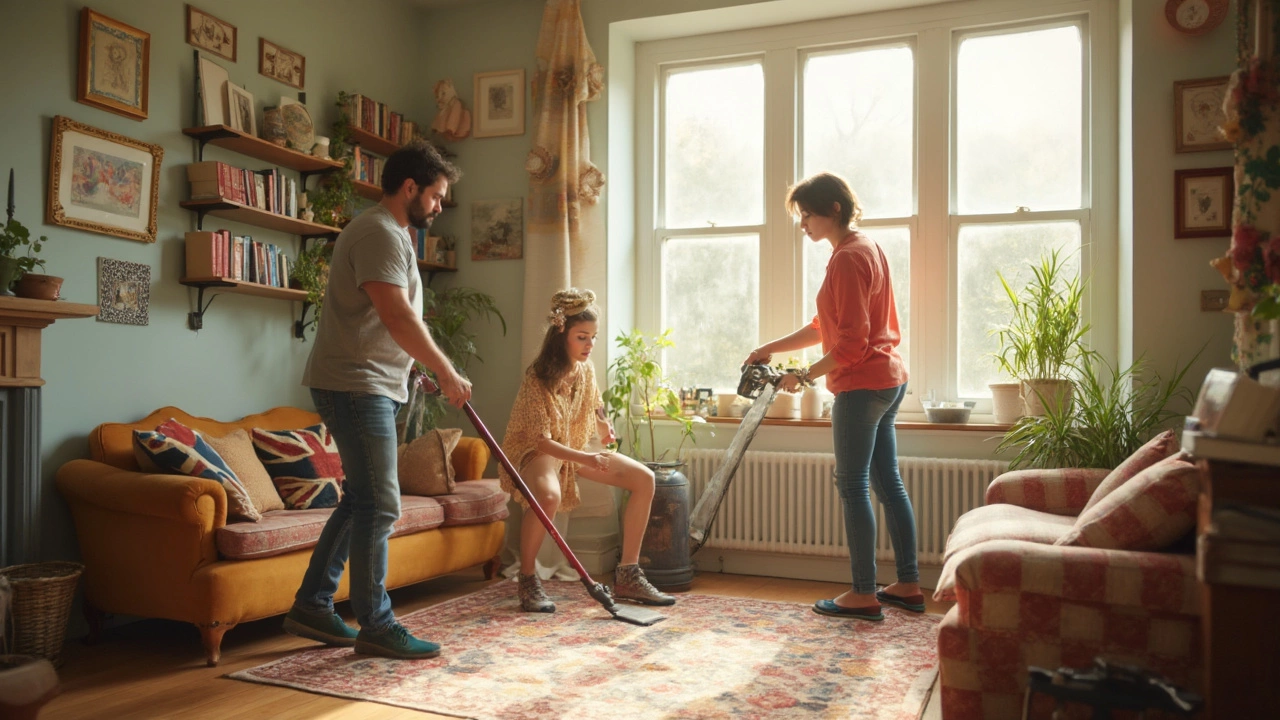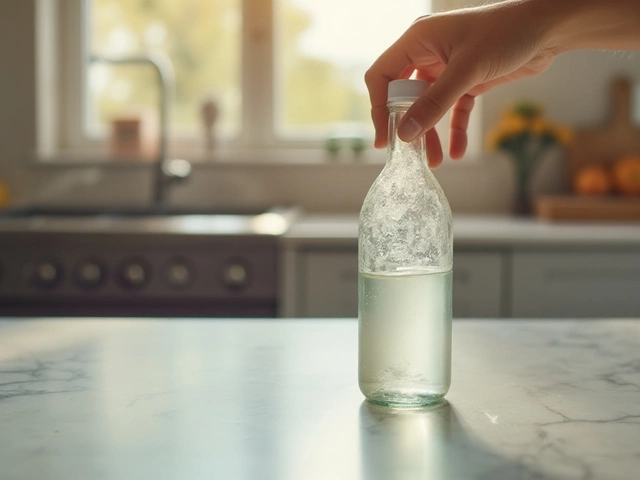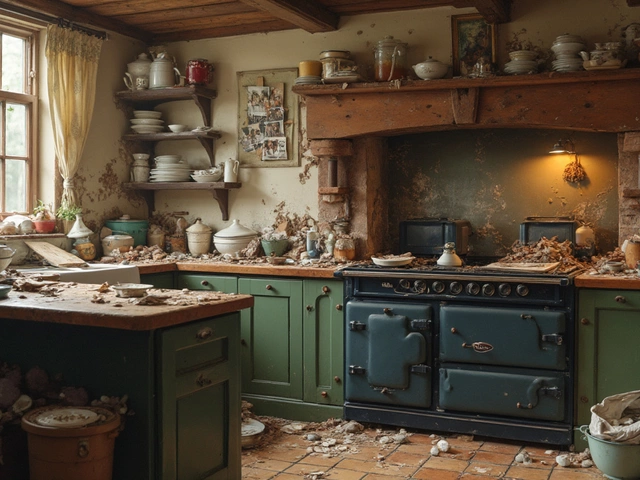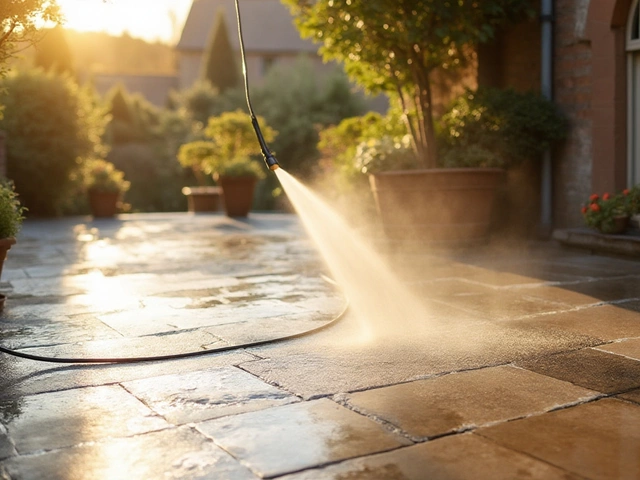Ever grabbed the vacuum and thought, "How long is this going to take me, really?" There’s no magic number, but most people are surprised when they finally track the hours. For a typical lived-in three-bedroom, two-bath home, expect anywhere from two and a half to five hours for a full top-to-bottom clean—if you’re not distracted and you actually hustle.
Time can double if you have clutter everywhere, a bunch of kids or pets, or if you’re deep-cleaning after a long winter. On the flip side, if you clean a little every day or your place is already tidy, you can cut that estimate in half. The size of your home, number of rooms, how many “extras” you handle (windows, baseboards, the fridge), and your own cleaning style all play a part. Nobody scrubs a house at the speed of a professional cleaning crew, and honestly, it’s okay.
- What Really Affects Cleaning Time?
- Breaking Down the Cleaning Task List
- Time Hacks for Faster Cleaning
- Staying Motivated and On Track
What Really Affects Cleaning Time?
When you’re figuring out how long house cleaning should take, lots of things come into play. First, the size matters a lot—cleaning a 900-square-foot apartment is a totally different beast from a 2,500-square-foot house. More rooms and bathrooms mean more ground to cover and more grime to deal with.
Then there’s clutter. If your counters and floors are covered in stuff, expect your spring cleaning to drag on. It’s not just about vacuuming or dusting—you’ll spend extra minutes moving things around, sorting, and maybe even shoving things in closets (no judgment). Places with less clutter always clean up faster.
How often you clean really adds up too. If you go weeks between deep cleans, dirt and dust build up. That means you’ll need more elbow grease and more time. Folks who clean up a little each day, like wiping down counters or quickly vacuuming once a week, can usually get through a full clean way quicker.
Also, pets and kids. They leave behind hair, crumbs, spills, and sticky fingerprints everywhere. If you’ve got two dogs and three toddlers, your cleaning time nearly doubles compared to someone living solo. Even just wrangling toys and tackling furballs can eat up a chunk of your day.
Here’s a quick look at how these factors play out:
| Home Size | Frequency | Kids/Pets | Average Cleaning Time |
|---|---|---|---|
| 1-2 Bedroom Apartment | Weekly | No | 1.5 - 2 hours |
| 3-Bedroom House | Bi-Weekly | Yes | 4 - 6 hours |
| Large Family Home | Monthly | Multiple Kids/Pets | 6+ hours |
Your own pace matters, too. Some people zip through chores; others get sidetracked by texting or endless coffee breaks (we’ve all been there). If you use the right tools—like a decent vacuum, good microfiber cloths, and multi-surface sprays—you’ll get done faster than someone still scrubbing floors with paper towels.
Breaking Down the Cleaning Task List
If you’ve ever looked around and felt overwhelmed, you’re not alone — breaking up the entire house cleaning session into smaller jobs makes things way more doable. Here’s the real breakdown most people use, with honest time estimates:
- Kitchen: 30-45 minutes if you’re wiping counters, cleaning appliances, doing dishes, and mopping the floor. Add 10 more minutes for deep-cleaning the oven or the inside of the fridge.
- Bathrooms: Each one usually takes 15-30 minutes, giving extra attention to the toilet, shower, and sinks. Doing more than the basics — like scrubbing grout — will obviously take longer.
- Bedrooms: Figure 15-25 minutes per room. That covers dusting, vacuuming, changing sheets, and picking up dirty laundry. If you’ve got stacks of clutter or haven’t cleaned in weeks, tack on another 10 minutes.
- Living room/common areas: Think 20-30 minutes for dusting, vacuuming, straightening up, and wiping down surfaces.
- Floors throughout: Plan a quick sweep or vacuum for the whole house and a mop in the kitchen or bathrooms. This can take 20-40 minutes total, depending on your home’s size.
Here’s a quick look at how it can all add up for a single person doing a basic, one-time spring cleaning:
| Area | Time (minutes) |
|---|---|
| Kitchen | 40 |
| Bathrooms (2) | 50 |
| Bedrooms (3) | 60 |
| Living/Other | 30 |
| Floors | 30 |
| Total | 210 (~3.5 hours) |
Of course, you can shave time off each spot by doing easy speed-clean hacks—like letting cleaner sit while you tackle something else, or using a lightweight cordless vacuum so you don’t have to fight with plugs. The best move: cut out the stuff you rarely need, unless you’re deep into spring cleaning. For your weekly or bi-weekly cleaning, ditch washing windows and deep scrubbing baseboards. Focus on what people actually notice.

Time Hacks for Faster Cleaning
If you’re tired of cleaning taking up half your weekend, you’re not alone. People who stay on top of spring cleaning swear by a few simple rules that keep the job moving fast. One big rule: don’t clean the same surface twice. Start at the top of the room and work your way down, so the dust you wipe off shelves or counters lands on the floor—then vacuum at the end.
Racing the clock seriously works. Set a timer for each room or task. Try giving yourself 15 minutes for the bathroom and 10 minutes for the kitchen counters—small deadlines help you move faster instead of getting stuck scrubbing one stubborn spot forever.
Keep your supplies together in a bucket or caddy (no running around looking for spray, sponges, or that one cloth you like). Toss dirty laundry in the hamper as you go. Use multipurpose cleaners so you’re not constantly switching bottles between surfaces.
- Vacuum last—always. You’ll avoid having to sweep twice.
- Delegate clutter duty: dump items into a basket and sort later instead of stopping to put every sock away immediately.
- Listen to music or a podcast—makes the time fly and you don’t notice the grind so much.
- If you have a cordless vacuum, charge it before starting. There’s nothing worse than running out of power halfway through the living room.
Need convincing that a few tweaks actually matter? A study published by the American Cleaning Institute found that using a set system or “path” to clean (for example, always starting left and working your way right around a room) saves up to 30% of cleaning time for the average house cleaning job. That’s at least an hour shaved off a decent-sized home.
Here’s a quick cheat sheet for typical room times if you use these hacks:
| Room | Average Time (minutes) | With Hacks (minutes) |
|---|---|---|
| Kitchen | 20 | 12-15 |
| Bathroom | 15 | 8-10 |
| Bedroom | 15 | 8-10 |
| Living Room | 20 | 10-15 |
So, next time you’re dreading a spring cleaning marathon, remember: a few smart changes can make your cleaning way faster. You get more free time and less stress, which makes everyone happier—including you.
Staying Motivated and On Track
When it comes to house cleaning, it’s way too easy to bail halfway or lose track of time in a pile of laundry. Motivation doesn’t just magically appear, but there are some hacks that make staying on track a lot easier.
First off, set a timer. Some people call it the "20-minute rule"—set your phone for 20 minutes and just focus on one task or room. Short bursts beat marathon cleaning sessions because they feel manageable. You’d be surprised how much of your spring cleaning you can knock out this way, and it keeps you moving.
Another tactic: Make a physical checklist. Breaking everything down into smaller, specific tasks gives you a confidence boost each time you check something off. Here’s a sample checklist for a regular clean:
- Vacuum or sweep all floors
- Wipe down kitchen counters and appliances
- Scrub bathroom fixtures
- Change bedding
- Empty trash cans
- Dust surfaces
If you want extra motivation, try blasting your favorite playlist, calling a friend on speaker, or turning chores into a game (“Can I clean the living room faster than making a cup of coffee?”). Small rewards help, too—think a snack or ten minutes of downtime after every room.
Accountability works wonders. If you tell someone you’re tackling your spring cleaning, you’re way more likely to see it through. Teams in a study by Harvard found that sharing goals with others, especially friends, increases your success rate significantly.
Lastly, track your progress. Here’s a look at average cleaning time for common rooms to see if you’re on pace or need to speed things up:
| Room | Average Time (min) |
|---|---|
| Kitchen | 30-45 |
| Bathroom | 20-30 |
| Bedroom | 15-25 |
| Living Room | 20-30 |
If you’re consistently slower, tweak your routine or look for ways to make the process smoother. Sometimes, it’s as simple as putting your cleaning products all in one caddy. The key is to keep moving, stay honest with your pace, and remember that nobody’s checking your corners with a white glove but you.





